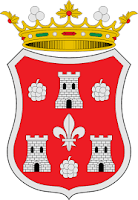LA IGLESUELA DEL CID
***Copy and translate from :http://www.laiglesueladelcid.es/el-pueblo/historia/
History
The structure of the urban nucleus of Iglesuela del Cid, as we know it today, arises with the foundation of said border town in the Middle Ages by the Military Order of the Temple, in accordance with the repopulation and defensive action promoted by the Christian kings.
Middle Ages. From S. XI to S. XV. Foundation
During the Arab domination possibly there was some type of building in this enclave although it is not proven that it coincided exactly in the location of the current town.
In 1089 El Cid settled in El Poyo, Calamocha. On his way to Levante he passed through Iglesuela, a fact referred to in a multitude of names «Muela del Cid», «Peña del Cid», even the Sanctuary of the Virgen del Cid (Ecclesiam de Cit) owes its name to devotion by Rodrigo Díaz de Vivar to the Romanesque Marian stature that was contained there and that is currently preserved in the Purification Church. In 1099 the Cid died and the mountain range passed into the domain of the Almoravids.
The population center is consolidated from the concession of the Puebla Charter (1242), this document regulated the conditions agreed by peasants and commenders on the distribution of lots, taxes required for the use of the mill and the oven…. Sixteen settlers settled in the first walled enclosure that develops from the apex of the peninsula to the central spaces where the Church and the Tower are located. With it, the current population center is consolidated with the settlement of the Templars.
In the fourteenth century the Order of the Temple is dissolved and La Iglesuela passes into the hands of the Order of San Juan del Hospital, at which time as a consequence of the war with Castile, the Hospital is founded to receive sick, injured and passers-by. During this period the Chapter Hall and the Tower of the Clouds are also built.
Modern age. From S. XVI to S. XVIII. Prosperity
There was a period of splendor, in which the large buildings of the population were built, as it appears in the date of construction of the facades and significant architectural elements were modified: the church was extended, the tower was raised ...
The civil architecture of the 16th to 17th centuries received Italian influences; 2 or 3 floors, gallery of arches on the ground floor, topped with large eaves of carved wood and half-point covers (e.g. Casa Guijarro or Casa Aliaga). In the eighteenth century typologies of the previous centuries survived with others renewed as the Matutano-Daudén House. (see civil cultural heritage)
The Church of the Purification was rebuilt and expanded, modifying the urban space of its immediate surroundings: the street of San Pablo narrowed with the extension of the layout of the wall of the first enclosure, the Ondevilla street was diverted and the square of the Church when invading it with a lateral ship.
Symptom of urban expansion due to demographic and economic growth, new extramural constructions appeared on the opposite banks of the streams (neighborhoods of the Coastal and Las Eras) and later stretches of wall were demolished that hindered urban growth.
The estimated population in Iglesuela del Cid in this period;
Year 1495 - 69 neighbors (Note: each neighbor equals four people).
Year 1718 - 75 neighbors
Year 1797 - 256 neighbors
First settlements
Prehistory
The deposits found in the municipality indicate an early settlement and a great continuity of later settlements. Remains have been found covering a wide chronological arc that goes from prehistory: Neolithic (burial in the Matutano Cave), Bronze Age (La Molota, Los Cabezos, La Cueva del Turcacho and La Cueva Bonifacia) and Hierro I (El Puntal del Moro), passing through the Iberian era and the Roman Empire (La Peña del Morrón) until the Middle Ages.
Ibero-Roman
From the Iberian era (s. II-I a. C.) there are 3 inscriptions that are now part of the walls of the hermitage, then the town was called Atheba.
From the Roman era (s. I-II AD) the following remains remain:
-The communication channels where the tracks are still visible.
-Cistern excavated in the ground
-Inscriptions:
-Pedestal at the entrance of the hermitage
-Two dedications in a corner of the temple.
-Numerous ashlars in the corners of the sanctuary.
- Funeral monument inside the hermitage.
XIX century. Carlist Wars, anger and isolation
The inaccessibility of these lands made them a refuge for the insurgents. In 1836 Cabrera established his headquarters in the nearby town of Cantavieja and fortified the town, making some new constructions or reinforcing the existing ones.
The population continued to increase despite the deaths caused by the cholera epidemic of 1885.
Twentieth century. At the beginning (maximum population and at the end (Emigration)
The municipalities of the Maestrazgo reached their highest population levels between the end of the 19th century and the beginning of the 20th century, in the case ofIglesuela 1486 inhabitants in 1910. In this period the Convent of the Paules was built and the current road that connects the population with Cantavieja and Mosqueruela, later becoming the main commercial hub and center of the social life of the nucleus.
Civil war
During the Civil War there were significant losses in movable assets and damage to property, especially the towers. The hardness of the postwar period facilitated the disappearance of numerous constructions.
The war avatars of the nineteenth and twentieth centuries caused it to be lost
Important documentation about the territory.
In the middle of the 20th century, the isolation prevented the arrival of techniques to improve textile production and made it difficult to export the products. All sectors entered into crisis and a rural exodus and a demographic regression originated that has not stopped until today.
Year 1950 - 1075 neighbors
Year 1982 - 606 neighbors
Year 2006 - 492 neighbors
XXI century. Turimso and second homes
In the years 80-90 restoration works of outstanding buildings were undertaken (Town Hall, Matutano-Daudén House, Blinque House ...) and communication roads with some neighboring towns were improved.
La Iglesuela del Cid seeks in tourism one of the forms of development of the town. Especially in summer, a high percentage of people return to the homes of their ancestors - which during the rest of the year are empty - or overnight in tourist accommodation: the Hospedería; the Hostel or the 4 rural houses.
***Copy and translate from :http://www.laiglesueladelcid.es/el-pueblo/historia/





Comments
Post a Comment